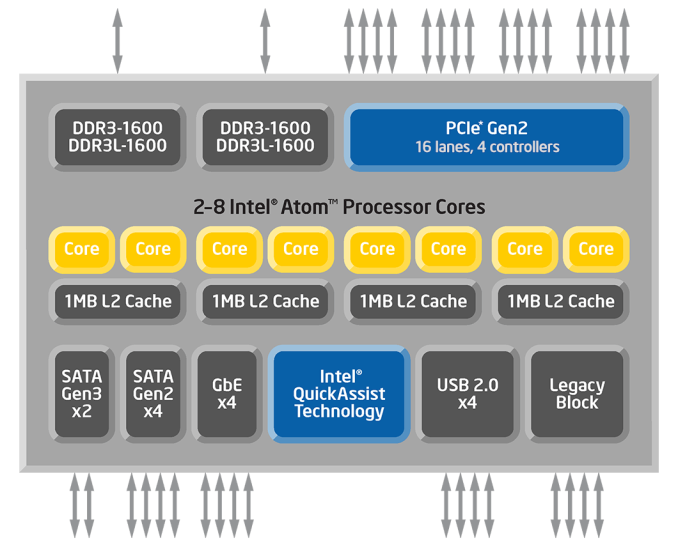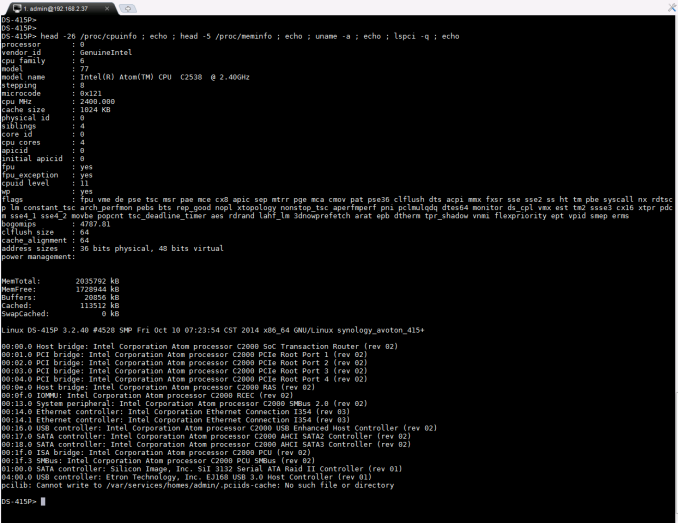Synology DS415+ Review: DSM on Intel Rangeley
by Ganesh T S on October 30, 2014 7:30 AM EST- Posted in
- NAS
- Storage
- Intel
- Synology
- Silvermont
- Enterprise
- Rangeley
Platform Analysis
The higher end segment of the SOHO / SMB NAS market uses Intel's Core-series and Xeon CPUs to deliver the required performance while supporting a large number of drive bays (typically more than 8, in a rackmount form-factor). Over the last four years or so, Intel's play in the other tiers has been mainly with its Atom CPU lineup. Back in 2010, Intel pushed the 45 nm Atom D410 / D510 / D525 for NAS units. In 2012, it was the 32 nm Atoms, the D2550 and D2700. All of these were based on the in-order Bonnell microarchitecture which was fast becoming dated compared to the advancements being made by the ARM SoC vendors. In moving from 32nm to 22nm, Intel completely revamped the microarchitecture for their Atom cores. Bonnell was replaced by Silvermont, bringing out of order execution and other improvements into the picture. Silvermont's applicability to a variety of power profiles meant that there were multiple product lines that ended up using the CPU cores. Bay Trail is proving very effective in tablets and also makes up QNAP's TS-x51 and TS-x53 Pro NAS series. Merrifield and Moorefield are trying to break into smartphones, but it is Avoton and Rangeley that are more relevant to the storage appliances market.
The different product lines integrated different I/O around the Silvermont cores depending on the target market. Avoton is meant for microservers and cloud storage platforms, while Rangeley is meant for communication and network infrastructure. Both of them integrate similar I/O around the cores, but the Rangeley parts have an updated crypto engine. The block diagram of a generic Rangeley part is provided below.
There is a wealth of I/O (2x SATA Gen 3, 4x SATA Gen 2 and up to 16 PCIe 2.0 lanes) for the storage subsystem, and the parts also support up to 4x 2.5 Gbps network links. From the viewpoint of the Synology DS415+, the above block diagram should be considered in the context of the information gleaned via SSH access to the unit.
The DS415+ uses the Intel Atom C2538 SoC which has four Silvermont cores running at 2.4 GHz. It is backed up by 2 GB of DRAM. The Atom C2538 has 16 PCIe 2.0 lanes across four controllers. The Silicon Image SiI3132 PCIe to 2-port SATA II host controller uses a single PCIe 2.0 lane on the host side. The device side can support port multipliers. Synology indicates that the eSATA port on the DS415+ can be used to connection an expansion chassis. However, unlike the scalable series, the external chassis can't be used to expand existing volumes in the main unit. The other chip connected to the SoC via PCIe is the Etron EJ168 USB 3.0 host controller. It also uses a single PCIe 2.0 lane on the host side and provides two USB 3.0 ports. These two enable the eSATA and the 2x USB 3.0 ports on the rear of the unit. The single USB 2.0 port in the front comes directly off the Atom C2538. Obviously, in a platform like Intel Rangeley, there is no need for SATA - PCIe bridges.
The more interesting aspect is the two Ethernet controllers. Unlike the Intel I211 GbE controllers in the Seagate NAS Pro 4-bay that we looked at earlier, the Synology DS415+ uses the Intel I354 2.5G Ethernet controllers. Despite being 2.5G-capable, Synology only advertises GbE links [Update: Synology clarified that even though the controllers are rated for 2.5Gbps, the transceivers they are linked to limit the rate to 1 Gbps]. Perhpaps, when the NBASE-T Alliance initiatives take off, we can get official 2.5Gbps ecosystem support from Synology as well as affordable and efficient peripherals. Current 10GBASE-T switches still need some updates to be more power efficient, and adoption is still not high enough to force pricing downwards.
On the software front, the DS415+ runs Linux (kernel version 3.2.4). We have covered DSM 5.0's setup and usage impressions in our recent DS214play and DS414j reviews. There is not much point in rehashing the same excellent setup and usage experience. That said, with the ioSafe 1513+, we also started looking at iSCSI support in NAS units. We will be looking at that aspect in this review also.












41 Comments
View All Comments
ganeshts - Thursday, October 30, 2014 - link
Encryption testing is with a single client. The limitation is on the client side which has only a single GbE link.Reason it is done this way is to make sure we have data that can be compared against other units that have been evaluated before.
thewishy - Friday, October 31, 2014 - link
Well, the client side isn't entirely the problem here. You could do LACP on the client side too, and still only see gigabit. Ethernet was never designed to receive frames out of order, and the two interfaces aren't easily syncronised - so traffic between a pair of endpoints is sent over only one link. Fine and dandy for busy networks, poor in this scenarioSonic01 - Tuesday, November 4, 2014 - link
Makes sense, it's a shame you guys don't test this as some of us might be using a client or server configured with link aggregation.I've purchased this NAS, a LAG capable switch and network card for my desktop and server, will see what kind of performance I get...
xenol - Thursday, October 30, 2014 - link
Gallery: Gallery Title!I laughed harder than I should at that.
shelbystripes - Thursday, October 30, 2014 - link
Two questions I can't find the answers for anywhere:1) Does the 415+ come with ECC RAM?
2) If not, does it work if you put ECC RAM in it?
One of the key potential benefits of Avoton/Rangeley is support for ECC RAM, but Synology doesn't mention it, and it seems like the kind of thing you'd advertise (or at least list in the specifications) if you used it.
ganeshts - Thursday, October 30, 2014 - link
Nope, no ECC RAM. The platform may support it, but Synology's board doesn't. At this price point, ECC support is difficult to get.shelbystripes - Thursday, October 30, 2014 - link
ganeshts: I don't understand this. I'm not saying I don't understand you, or don't believe you. (If I didn't think your answer was possible, I wouldn't have asked the question.) What I am saying is, I don't understand why ECC RAM isn't supported in this model.From the block diagram under "Platform Analysis", it appears that the memory controller is built into the CPU/SoC, and the C2538 they're using does support ECC RAM. DDR3 SODIMMs are 204-pin whether they're ECC or not, and while it's not really discussed in this review, a teardown on legionhardware.com shows the memory as a single SODIMM module. Since Synology is using an SoC with an integrated ECC-capable memory controller, I can't understand why they would leave out ECC memory support. It seems like it would have to be an active choice on their part not to, in order to discourage people from sticking in ECC RAM on their own. (Synology doesn't like its users upgrading RAM and claims that doing so will void the warranty, which is something the PC industry stopped pulling a decade ago.) All the necessary hardware should be there, right? So why doesn't it work if you just stuck an ECC UDIMM in there? Did Synology actively disable this feature of the SoC?
chubbypanda - Thursday, October 30, 2014 - link
While dimensions and sockets for DDR3 and ECC DDR3 modules are physically the same, they've got different electrical layouts! Inserting regular memory module into ECC DDR3 equipped board would result in damaged memory module and possibly the board.As why Synology chose not to use ECC memory (despite they could have), Ganesh already answered that.
jabber - Friday, October 31, 2014 - link
Plus it leaves them open to sell a version in the future that does support ECC and charge you an extra $400 for the benefit.shelbystripes - Friday, October 31, 2014 - link
Chubbypanda: Thanks for your reaponse, it put me on the right track.I was about to say that I don't buy this, since both ASUS and SuperMicro make Avoton boards that are listed as taking both ECC and non-ECC RAM. But on a closer look, only the SuperMicro mATX boards (which have full-size 240-pin DIMM sockets) claim to support both ECC and non-ECC RAM. Their mini-ITX boards (which have 204-pin SODIMM sockets) support ECC RAM only. The missing pins in SODIMMs must be ones that would allow cross-compatibility (probably by providing separate electrical signals for ECC and non-ECC RAM, at least for detection at startup).
I think that's it. Since the Synology unit uses SODIMMs, it can only support one or the other, and they chose non-ECC. Boo. If (as jabber mentioned) they release a higher-end version with ECC RAM, I'll buy it... If I haven't given up waiting for it and built myself a FreeNAS box. I had been waiting and hoping for the inevitable Avoton Synology box, but I hadn't anticipated this.